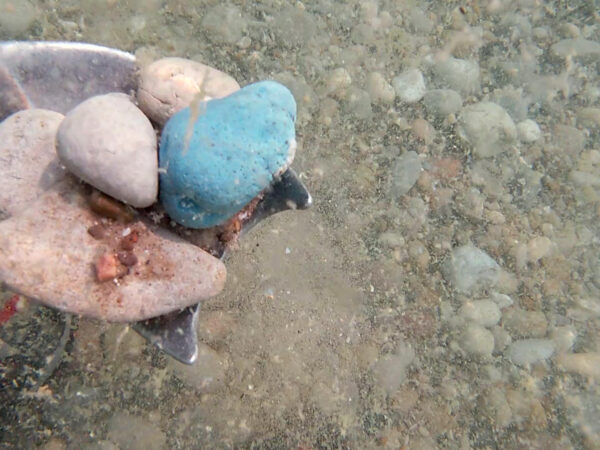
Early in October, scientists who pioneered a powerful gene-editing technology won the Nobel Prize in Chemistry. That same technology is now being used to explore new ways to control invasive sea lamprey in the Great Lakes.
When researchers suggested earlier this year that it might be possible to eradicate sea lamprey from the Great Lakes, it was with developing gene-editing technology in mind.
While the ability to produce enough genetically altered sea lamprey, much less release them in the Great Lakes, is years away yet, researchers are taking the first, cautious steps toward that goal.
New technology, old organism
Sea lamprey are an ancient species, so researchers have studied their DNA for years for clues about the early evolution of vertebrates. Some researchers who did that early research into sea lamprey DNA are now exploring the idea of turning it against the Great Lakes’ invasive population.
Weiming Li, a professor of fisheries and wildlife at Michigan State University, helped sequence the sea lamprey genome for the first time and published that research in 2013. Soon, he will be looking into techniques for editing many lampreys at once.
“If we want to edit a gene in a sea lamprey, we can do it. It’s not difficult. Generating large numbers of gene-edited lamprey is still difficult,” said Li, who will soon occupy new lab space at Michigan State University to pursue this research.
Editing a large number of animals requires adapting techniques that work already in several species frequently used in research like mice, Li said. Editing animals in large batches is a necessary – though very early – step toward any sort of genetic biocontrol, or releasing gene-edited animals into the wild to control an invasive species.
“The impetus for our research is definitely to generate animals suitable for sea lamprey control, but that goal is a long-term goal,” Li said.
One way gene editing could be used to suppress sea lamprey populations is by skewing the male-to-female ratio of lamprey offspring. Several generations of lamprey with higher proportions of male lamprey could eventually drive down the population by reducing the number of reproducing females. If no females are left to mate, no new sea lamprey can be born.
In sea lampreys, sex is determined by the production of certain proteins. If a sea lamprey gene could be edited to stop the production of one such protein, aromatase, a sea lamprey would develop as a male.
“If we could pass along a defective aromatase gene to the next generation, then all the progeny would be male,” said David McCauley, professor of biology at the University of Oklahoma.
After the first generation, the aromatase-disrupting gene could still be passed on, but the following generation would not be all males. Managers would need to release more genetically altered males in order to keep the sex-ratio skewed.
McCauley said this isn’t what’s called a universal gene drive, which could spread a gene unhindered into an entire population.
“Any sort of genetic biocontrol would have to include some safety or kill switch,” he said.
This past summer he set out to see if he could edit sea lamprey genes to disrupt the production of tyrosinase, the protein that controls a sea lamprey’s pigment. Without tyrosinase, sea lamprey would be white.
He’s had some success, though he’s still gathering data before publishing the research. He needs to verify whether or not the sea lamprey lacked pigment because his editing worked, or because of some other disruption.
If he successfully silenced tyrosinase, it would suggest it’s possible to silence aromatase, the protein that helps determine sex.
McCauley said that any Great Lakes application is entirely hypothetical at this point. Both he and Li stressed they are simply asking the question, “Can we do this?”
“It’s simply a feasibility study,” he said.
What is our responsibility?
An equally important question to “Can we do this?” is “Should we do this?”
Several concerns need to be addressed, said Christopher Preston, professor of environmental ethics at University of Montana, who studies and writes about gene editing in nature but hasn’t studied the sea lamprey case.
One is the effects of gene editing within the species beyond the initial expected one. Preston raised a hypothetical mosquito that has been gene edited for infertility but with the unintended consequence of increased aggression.
Another is the secondary effects within the ecosystem, the “knock-on effects,” Preston said. These include the implications for animals that eat the hypothetical mosquito or the possibility that a worse pest will take its place.
Any release of a gene-edited animal is going to be very context specific, Preston said. The risks and responsibilities vary in each application.
Those risks will be very carefully considered, said Marc Gaden, communications director for the Great Lakes Fishery Commission.
While the commission is in the very early stages of considering genetic biocontrol, there’s good reason to look into it, he said. Research shows that there is public support for research. And, if it leads to viable genetic biocontrol, the commission would have a new centerpiece in their campaign against sea lamprey.
If the commission continues to fund research into genetic biocontrol, it will also work to understand public opinion while consulting with scientists and ethicists on the risks, he said.
Years from now, if genetically engineered sea lamprey hit the Great Lakes’ waters, it’ll only be with a thorough assessment of any risks.
“You don’t want to create a problem trying to solve a problem,” Gaden said.
Read more on sea lamprey and other invasives on Great Lakes Now:
Complete Eradication: Researchers look at removing sea lamprey from the Great Lakes
Report shows mixed results on Great Lakes lamprey control
Carp Advance: Real and potential impacts of invasive fish throughout the Midwest
Dams Across the Great Lakes: End of the line for aging infrastructure?
Least Wanted: Potential Great Lakes invasive species are little known but still a big problem
API key not valid. Please pass a valid API key.Featured image: An up-close photo of a sea lamprey’s mouth (Photo courtesy of Great Lakes Fishery Commission)




